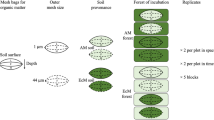Abstract
In a Dutch Scots pine forest an experiment was conducted to quantify the role of soil biota in the functioning of the soil ecosystem, and the effects of enhanced nitrogen deposition. For this, the site was sampled at 8-week intervals during 2.5 years. This paper reports on the population dynamics of enchytraeids in the field and in stratified litterbags. Mean yearly abundance of the enchytraeid community in the field was 47 600 m–2, or 0.70 g (dry weight) m–2. The community consisted mainly of three species: Cognettia sphagnetorum, Marionina clavata and Achaeta eiseni, of which C. sphagnetorum was dominant. The enchytraeid populations showed a marked stratification in the same sequence. Freshly fallen pine needles were colonized by C. sphagnetorum, while other species followed much later. It was found that data from the litterbags were reasonably comparable with field data, when expressed per gram of dry substrate, but less so when expressed per square metre. Multiple regression analysis of the data showed that the population dynamics in the litter layer could largely be explained by temperature and moisture fluctuations; in deeper layers other factors, such as the stage of decomposition, were probably more important.
Similar content being viewed by others
Author information
Authors and Affiliations
Additional information
Received: 26 June 1997
Rights and permissions
About this article
Cite this article
Didden, W., de Fluiter, R. Dynamics and stratification of Enchytraeidae in the organic layer of a Scots pine forest. Biol Fertil Soils 26, 305–312 (1998). https://doi.org/10.1007/s003740050381
Issue Date:
DOI: https://doi.org/10.1007/s003740050381




